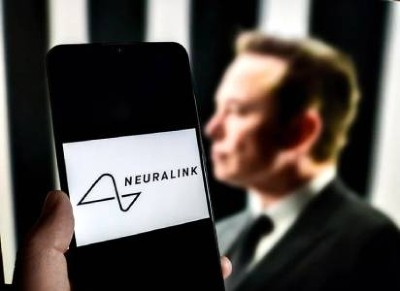
Neuralink officials say their brain implant could one day help humans to work in symbiosis with artificial intelligence.Credit: Jakub Porzycki/NurPhoto/Getty
Elon Musk’s firm Neuralink has implanted a brain–computer interface (BCI) in a second person and could implant eight more of the devices this year, Musk said.
In an 8-hour long podcast released on 2 August, Musk said that the second implant is working well and that roughly 400 of its 1,042 electrodes are providing signals from the recipient’s brain. Musk did not reveal details about the the implant surgery or the recipient except to note that the person has a spinal cord injury, as does Noland Arbaugh, the first recipient of a Neuralink BCI.
Now scientists are waiting to see whether the company, which is headquartered in Fremont, California, can avoid the mechanical difficulties that plagued the implantation of its first device in January.
“This is necessary advancement,” says Sameer Sheth, a neurosurgeon and neurotechnology researcher at Baylor College of Medicine in Houston, Texas. “I really hope they can keep doing this safely. There’s a lot that they can contribute to human health and disease.”
Sited in the skull
Neuralink’s BCI, dubbed Telepathy, is the third commercial BCI implant to undergo long-term testing in humans. The others include arrays of electrodes that either attach to the inside of a cerebral blood vessel or sit directly atop the brain. Telepathy instead has a roughly coin-sized electronics hub that is placed in a hole that is made in the recipient’s skull. From this hub, 64 flexible threads run through the fluids and membranes surrounding the brain and into the recipient’s cortex.
A surgical robot designed by Neuralink inserts these threads into the motor cortex, the brain region that controls movement. The process takes 20 to 40 minutes, Dongjin Seo, Neuralink’s cofounder and president, said in the podcast. Each thread has 16 recording sites, yielding a total 1,024 electrodes that can potentially record neural activity and send signals to an external device via Bluetooth.
Elon Musk’s Neuralink brain chip: what scientists think of first human trial
The first person to receive a Neuralink BCI was Noland Arbaugh of Yuma, Arizona, who was paralysed from the neck down during a diving accident in 2016. He can now use the device to control a cursor on a computer screen to, for example, play games.
But a month after Arbaugh’s BCI was implanted, 85% of its flexible threads, which record neural activity, retracted from his brain. That diminished the device’s capabilities, which was “really, really hard,” Arbaugh said in the podcast. “It would’ve been a cruel twist of fate if I had gotten to see the view from the top of this mountain and then have it all come crashing down after a month.”
Neuralink engineers responded by changing the recording algorithm that converts neural data into commands that are conveyed to the computer. The original algorithm recorded the activity of individual neurons, but the revamped version records the average activity of neurons near each electrode. Although the average signals are lower in resolution, the effects were immediate.
“Why are we taking this much risk and implanting this many threads, if it’s working quite well, and better and better with fewer threads?” wonders Sheth.
In a livestream on X on 10 July, Matthew MacDougall, Neuralink’s head of neurosurgery, said that the first surgical process caused an air pocket that might have later dislodged the electrodes. He said that the surgical team placing the second implant would try to avoid creating such air pockets and would sculpt the hole differently, to allow the hub to sit lower in the cranium and thread the flexible electrodes deeper into the cortex.
“It’s not common” to make so many changes in the BCI-implantation process between recipients, says Sheth. “But I think it’s good that you learn from the first one, and then you really make the second one better.”
Questions about stability
Still, Vikash Gilja, chief scientific officer at rival BCI company Paradromics, based in Austin, Texas, says that questions about the device’s stability and durability need answering.
The brain, Gilja says, “is not just sitting there static relative to the skull”: it moves as a person breathes and moves. It’s not clear whether this minor but continuous movement will negatively affect electrode threads that run from the skull through membranes called dura to the brain, Gilja says.
The long-term stability of the materials that make up Neuralink’s electrodes is another unknown. Other BCI implants use various metallic electrode types with established longevity track records. ”You only understand the time constants once you’re in the human body,” Gilja says. Devices, he says, must be studied for years, not months.
Long-term plans
Musk said during the 10 July livestream that Neuralink plans to frequently offer upgraded devices, each of which would be implanted during another neurosurgery. By contrast, Paradromics calls for “as long a gap between successive neurosurgeries as possible”, Gilja says.
Musk said in the podcast that Neuralink’s ultimate goal is a BCI that allows humans to enter symbiosis with artificial intelligence. And he predicted that future BCIs will help people with psychosis, seizures and memory loss.
Sheth says treating such conditions is a much greater challenge than enabling people to move computer cursors, adding that human augmentation demands careful discussion.
More immediately, Anna Wexler, a neuroethicist at the University of Pennsylvania in Philadelphia, says these predictions risk misleading potential study volunteers. “It certainly raises questions about what’s drawing these people into the studies and what they’re understanding about what they’re getting into.”



